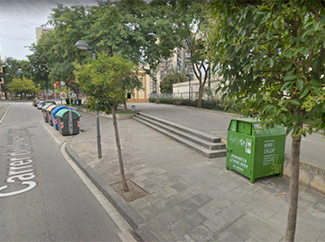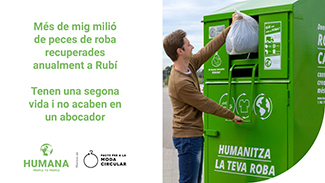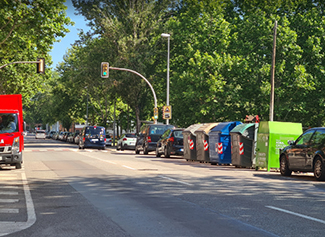consent_cookie
Duración: 1 year
Stores the user's cookie consent state
12-02-2024
More than half a million pieces of clothing recovered annually have a second life and do not end up in a landfill. It is the main balance of Humana's work in Rubí (Barcelona) since the social economy organization manages the selective collection service for used clothing.
Humana recovers an annual average of 135 tons of used clothing in Rubí, the annual equivalent of 546,000 items of clothing, thanks to donations from citizens.
90% of the clothing discarded by the people of Rubin has a second life thanks to reuse and recycling, two key elements for the circular economy and the creation and maintenance of quality jobs.
Furthermore, the management of this textile waste avoids the annual emission of 823 tons of CO2 or what is the same: it is the carbon dioxide emitted by 1,900 cars that circulate 15,0000 km each or that absorbed by 37,500 trees during a year.
Textile waste (clothing, footwear, accessories and household textiles that are no longer used) is deposited in the 45 green containers located in easily accessible places, which are emptied periodically (between one and two times a week) to guarantee a good service. Subsequently, it is classified in the preparation plant for reuse that Humana has in L'Ametlla del Vallès (Vallès Oriental).
9 out of 10 garments have a second life
“The selective collection of clothing has great potential to guarantee a second life: almost 60% can be reused and 32% recycled. The first objective is always reuse because the most sustainable garment is the one that has already been manufactured and has no more costs or production impact. That is why it is important that the clothes we get rid of are deposited in the corresponding container, because unfortunately almost 90% of the textile waste does not end up at the appropriate collection point but in the trash," says Rafael Mas, Director of Institutional Relations and Humana Projects.
“We appreciate the donations from citizens, who have supported us for decades. Humana is a non-profit entity that was born in Catalonia and Rubí, one of the municipalities in which we have been present for the longest time,” says Mas, who adds: “Separate collection is only successful with the combination of two factors: an environmental commitment on the part of the local administration and a professional and transparent service on the part of the managing entity. “Both elements coexist in the Vallesano municipality.”
Environmental and social benefit
The reuse of textiles contributes to the fight against climate change: for every kg of clothing recovered (and that does not end up in a landfill to be incinerated) the emission of 6.1 kg of CO2 is avoided, according to a study by the Federation Humana People to People. The 135 tons recovered by Humana annually in Rubí avoid the annual emission of 823 tons of CO2.


